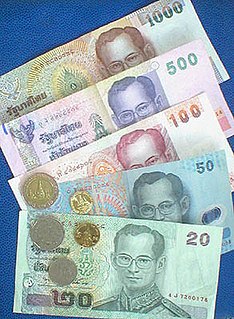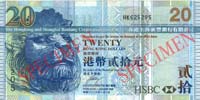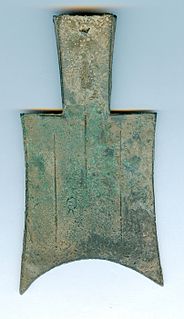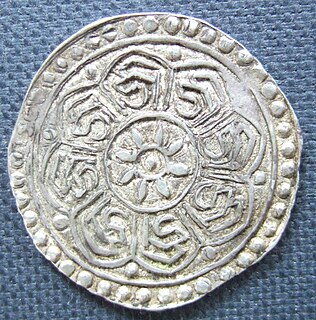A currency, in the most specific sense is money in any form when in use or circulation as a medium of exchange, especially circulating banknotes and coins. A more general definition is that a currency is a system of money in common use, especially for people in a nation. Under this definition, US dollars (US$), pounds sterling (£), Australian dollars (A$), European euros (€), Russian rubles (₽) and Indian Rupees (₹) are examples of currency. These various currencies are recognized as stores of value and are traded between nations in foreign exchange markets, which determine the relative values of the different currencies. Currencies in this sense are defined by governments, and each type has limited boundaries of acceptance.

The shilling is a unit of currency formerly used in Austria, the United Kingdom, Australia, New Zealand, United States and other British Commonwealth countries. Currently the shilling is used as a currency in four east African countries: Kenya, Tanzania, Uganda and Somalia. It is also the proposed currency that the east African community plans to introduce . The word shilling comes from old English "Scilling", a monetary term meaning twentieth of a pound, and from the Proto-Germanic root skiljaną meaning 'to separate, split, divide.' The word "Scilling" is mentioned in the earliest recorded Germanic law codes, those of Æthelberht of Kent.

The baht is the official currency of Thailand. It is subdivided into 100 satang. The issuance of currency is the responsibility of the Bank of Thailand.

Rupee is the common name for the currencies of India, Pakistan, Indonesia, the Maldives, Mauritius, Nepal, Seychelles, and Sri Lanka, and of former currencies of Afghanistan, Tibet, Burma, British East Africa, German East Africa, the Trucial States, and all Gulf Arab Countries.

The Hong Kong dollar is the official currency of the Hong Kong Special Administrative Region. It is subdivided into 100 cents. The Hong Kong Monetary Authority is the governmental currency board and also the de facto central bank for Hong Kong and the Hong Kong dollar.
The mill or (₥) is a now-abstract unit of currency used sometimes in accounting. In the United States, it is a notional unit equivalent to 1⁄1000 of a United States dollar. In the United Kingdom it was proposed during the decades of discussion on the decimalisation of the pound as a 1⁄1000 division of the pound sterling. Several other currencies used the mill, such as the Maltese lira.

The solidus, nomisma, or bezant was originally a relatively pure gold coin issued in the Late Roman Empire. Under Constantine, who introduced it on a wide scale, it had a weight of about 4.5 grams. It was largely replaced in Western Europe by Pepin the Short's currency reform, which introduced the silver-based pound/shilling/penny system, under which the shilling functioned as a unit of account equivalent to 12 pence, eventually developing into the French sou. In Eastern Europe, the nomisma was gradually debased by the Byzantine emperors until it was abolished by Alexius I in 1092, who replaced it with the hyperpyron, which also came to be known as a "bezant". The Byzantine solidus also inspired the originally slightly less pure Arab dinar.

The đồng has been the currency of Vietnam since May 3, 1978. Issued by the State Bank of Vietnam, it is represented by the symbol "₫". Formerly, it was subdivided into 10 hào, which were further subdivided into 10 xu, neither of which are now used. Since 2012 the use of coins has decreased greatly, and since 2014 coins are generally not accepted in retail, but will still be accepted in some, but not all, banks.

The history of Chinese currency spans more than 3000 years. Currency of some type has been used in China since the Neolithic age which can be traced back to between 3000 and 4500 years ago. Cowry shells are believed to have been the earliest form of currency used in Central China, and were used during the Neolithic period.

Compressed tea, called tea bricks, tea cakes or tea lumps, and tea nuggets according to the shape and size, are blocks of whole or finely ground black tea, green tea, or post-fermented tea leaves that have been packed in molds and pressed into block form. This was the most commonly produced and used form of tea in ancient China prior to the Ming Dynasty. Although tea bricks are less commonly produced in modern times, many post-fermented teas, such as pu-erh, are still commonly found in bricks, discs, and other pressed forms. Tea bricks can be made into beverages like tea or eaten as food, and were also used in the past as a form of currency.
The earliest coinage of Asia is also the oldest coinage of the world. Coins were invented several times independently of each other. The earliest coins from the Mediterranean region are from the kingdom of Lydia, and are now dated ca. 600 BCE. The dating of the earliest coins of China and India is difficult and the subject of debate. Nevertheless, the first coins of China are at least as old as the earliest Lydian coins and possibly older, while the earliest coins of India seems to have appeared at a later stage.

Cash was a type of coin of China and East Asia, used from the 4th century BC until the 20th century AD, characterised by their round outer shape and a square center hole. Originally cast during the Warring States period, these coins continued to be used for the entirety of Imperial China as well as under Mongol, and Manchu rule. The last Chinese cash coins were cast in the first year of the Republic of China. Generally most cash coins were made from copper or bronze alloys, with iron, lead, and zinc coins occasionally used less often throughout Chinese history. Rare silver and gold cash coins were also produced. During most of their production, cash coins were cast, but during the late Qing dynasty, machine-struck cash coins began to be made. As the cash coins produced over Chinese history were similar, thousand year old cash coins produced during the Northern Song dynasty continued to circulate as valid currency well into the early twentieth century.

The United States dollar is the official currency of the United States and its territories per the United States Constitution since 1792. In practice, the dollar is divided into 100 smaller cent (¢) units, but is occasionally divided into 1000 mills (₥) for accounting. The circulating paper money consists of Federal Reserve Notes that are denominated in United States dollars.

Spade money was an early form of coin and commodity money used during the Zhou dynasty of China. Spade money was shaped like a spade or weeding tool. Under the Xin dynasty created by Wang Mang spade money was reintroduced, there were 12 different types of spade money in the Xin dynasty ranging in values from 100 to 1000 qián.

The history of the taka, also known as the tanka or tangka, refers to one of the major historical currencies of Asia, particularly in the Indian subcontinent and Tibet. It was introduced in the 14th century and became a currency of the Silk Road. Its history is intertwined with the medieval Islamic history and culture of the Indian subcontinent.
The history of Philippine money covers currency in use before the Hispanic era with gold Piloncitos and other commodities in circulation, as well as the adoption of the peso during the Hispanic era and afterwards.




















